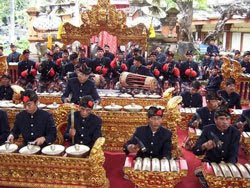Gamelan in Balinese life has many essential functions; the gamelan’s primary function is to assist in the myriad of ceremonies required during each 210-day cycle of the Balinese Pawukon cycle, as well as those involved with the lunar calendar. These activities range from private family observances such as weddings or the dedication to new buildings to massive, village-wide temple ceremonies. The musicians must be able to play at any hour or night or both, as demanded by the ceremony in progress. They may accompany a priest in his devotion, or they may accompany entertainments, such as temple dances.
Tourism creates the secondary function of any gamelan that is entertaining Bali’s visitors. There is no such thing as professional musician in Bali. The gamelan players are rice farmers or village artisans or work at some sort of job – they are musician during their time off.

A marching band that must accompany any religious procession is performed from a small group within the main gamelan, consisting of the percussion and gong players. Nearly every ceremony calls for a procession somewhere, often more than one. The cremation procession, the hallmark of Balinese ceremony, one of most often seen by the visitor to Bali, is accompanied by the Balaganjur marching gamelan as it follows the bearers of the bade ( decorated sarcophagus tower) to the cremation ground or accompanies the ashes of the deceased to the sea, to be thrown therein so that the soul can be released. The music is nothing like a dirge.

The sound of gamelan accompanies the daily life of Balinese from dawn until late at night. Early in the morning, the sound of gender gamelan that accompanies the morning prayer (Tri Sandya) will fill the air through the big loudspeakers installed in every Bale Banjar (public hall). In the afternoon, the sound of gamelan from various ceremonies held by the Balinese is the dominant sound of the day. Early in the evening until late at night, the hypnotic sound from gamelan’s rehearsal will accompany the Balinese enjoying their lovely evening and be a good “going to bed” music.
The gamelan is generally owned by a village neighborhood organization called banjar. Though many temples or brahmana family also own a small set of gamelan, played for ceremonial purpose only. Usually a club that desires to play forms within a banjar, a group of instrument is obtained, if there is none, and a teacher or a good leader is chosen to see all the required music is perfected and memorized. This is accomplished through endless rehearsal, often several times a week. Music is not written down in Bali. Nothing in a gamelan play is spontaneous or improvised. Everything is always performed in the same way one a piece is committed to memory. There is no variation. New pieces, yes- many. But once a new piece is learned it is always played the same way.

A banjar gamelan club may break up, however, leaving a gamelan, unused, to fall into terrible disrepair. The trend, to one might imagine, would be for the form to disappear. But gamelans are extremely competitive, and most groups actively seek to improve their skills and maintain their equipment. This competitiveness is actively fostered by the Indonesian government, which sponsors yearly festivals or competitions in which groups or individuals compete to be best or among the top three winners. The rapid growth of female gamelan club also bring a new breath in gamelan club activities and competition in Bali. In every gamelan competition, the female gamelan category is always full with competitors.








